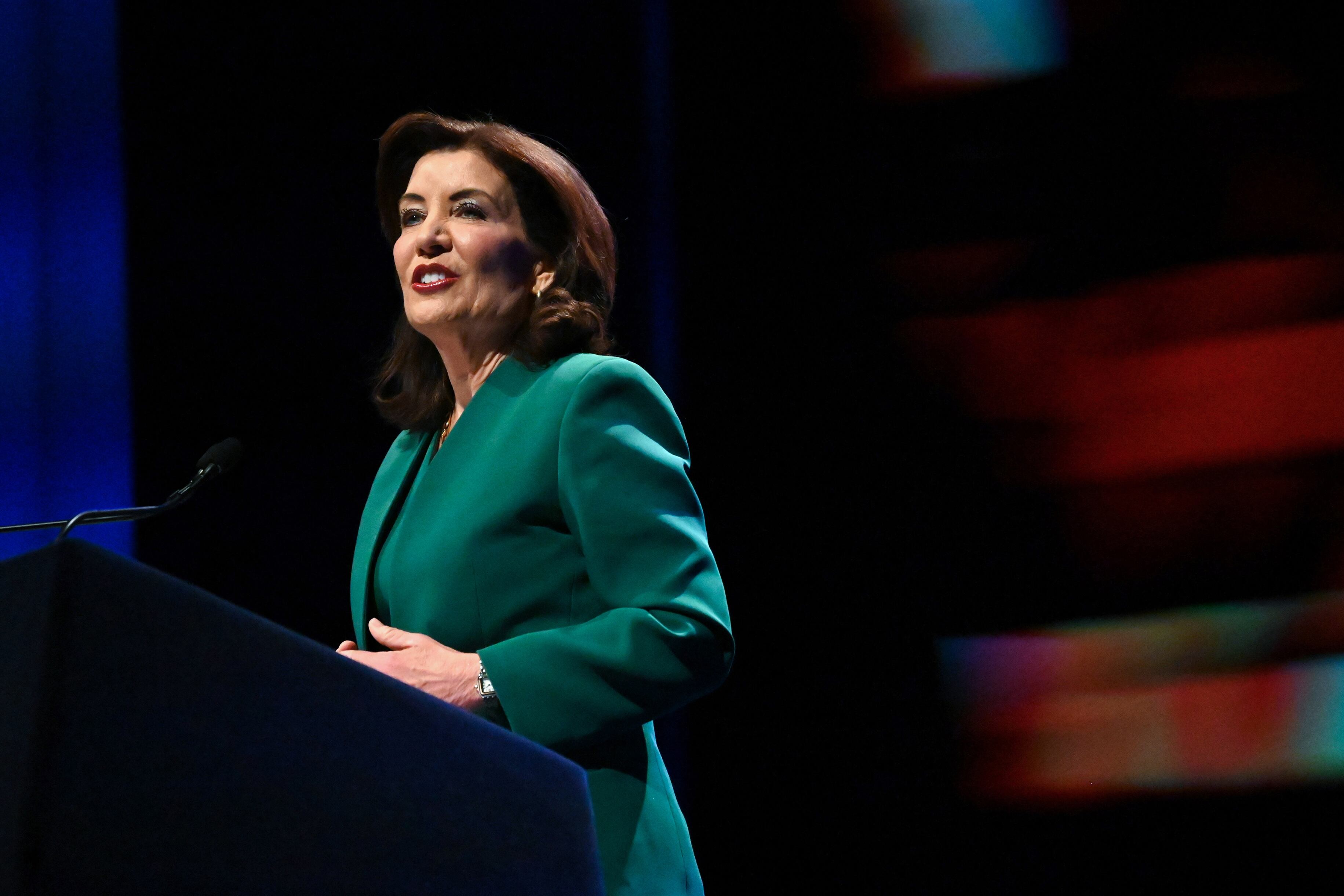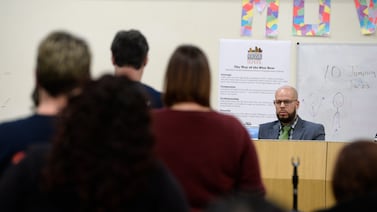Sign up for Chalkbeat New York’s free daily newsletter to get essential news about NYC’s public schools delivered to your inbox.
It’s official: After months of voicing concerns about the effects of cellphones on student mental health and learning, Gov. Kathy Hochul proposed a $13.5 million plan to help districts implement a ban.
Hochul said her plan would help create a “distraction-free” learning environment during the school day. The money aims to help cover associated costs that districts might incur, such as paying for digital pouches that lock devices or additional staff to collect phones each day. Covering the potential costs was one of the issues that forced New York City to put the brakes on its own ban, and it remains to be seen how far the governor’s proposed allocation will go.
On Tuesday, Hochul included the proposal in her $252 billion state 2026 budget, which would send $37.4 billion to schools across the state — a nearly $1.7 billion increase, or 4.7%, from the prior year’s budget. It builds on a broader agenda focused on affordability outlined by Hochul during her State of the State address last week.
The governor’s budget proposal marks the start of negotiations with lawmakers over how the state should allocate its funding for the next fiscal year, which begins in April.
Under Hochul’s cellphone proposal, students would be required to disconnect from devices from “bell to bell,” including during class time, lunch, and in the hallways. The policy would go into effect at the start of the next school year, with districts able to decide the specifics of how they would store phones and ensure compliance, according to Hochul’s office.
“Our kids will finally be free from the endless disruptions of social media and all the mental health pressures that come from it,” she said during her speech at the State Capitol.
Students with disabilities, as well as others who rely on digital devices for medical reasons or translation purposes, would be allowed exemptions from the policy.
In New York City, the Education Department appeared poised to implement a citywide ban on student cellphone use in schools last summer but later reversed course after intervention by Mayor Eric Adams.
Jenna Lyle, a spokesperson for the Education Department, said Tuesday that the department was “looking forward to partnering with the Governor” on the issue.
“The feedback we have heard from our school communities has been clear: access to cell phones in the classroom distracts from learning, divides attention, and significantly impacts our students’ mental health,” she said in a statement. “Following our engagement with parent leadership groups last spring, in partnership with the Health Department, we’ve been working on an evaluation to better understand both how schools are implementing policies to restrict cell phones, and lessons learned from those implementations.”
Currently, the city’s schools can make their own determinations over whether and how to restrict student cellphone use. At the end of last school year, about 350 schools already had bans in place, with an additional 500 planning to implement them this year, city officials previously said. Some schools provide students with locking Yondr pouches, while others collect phones or employ alternative strategies.
Those pouches (along with additional equipment, training, and support), though, can cost schools $30 per student in the first year, according to the company. Yondr CEO Graham Dugoni noted the company offered “volume discounts” in a statement and praised Hochul’s proposed cellphone ban.
“We look forward to supporting more school communities across New York in creating successful phone-free learning environments,” he said.
Adams, who has expressed some concerns about adopting a citywide policy on the issue, previously told reporters that the city would comply with any state mandate.
NYC could lose out under school funding formula proposal
Hochul’s proposed budget also called for updates to the state’s school funding formula, an issue expected to take center stage in education budget discussions this year. Known as Foundation Aid, the formula was originally created in 2007, and in some cases relies on decades-old data to determine how much funding is sent to school districts.
For years, advocates, lawmakers, and other education officials have called for updates to the formula, with some arguing it requires a complete overhaul. But the governor’s proposed updates — which were among the suggestions put forward by the state’s Board of Regents and a recent report issued by the Rockefeller Institute — could potentially result in New York City receiving a smaller funding increase, advocates warned Tuesday.
For one change, Hochul called for replacing the 2000 Census poverty rate with the most recent Census Small Area Income and Poverty Estimates, or SAIPE, data. The formula should also stop using federal free- and reduced-price lunch eligibility as a basis for measuring student need, the governor said, instead switching to broader “economically disadvantaged” student counts.
“This will ensure that state dollars go to students who need them the most,” Hochul said.
But according to the more than 300-page report issued by the Rockefeller Institute last month, switching from the 2000 Census Bureau poverty count to three-year average SAIPE data would decrease New York City’s Foundation Aid funding by a projected $392 million. (The city’s schools would still see an overall increase to Foundation Aid funding.)
Kim Sweet, executive director of the nonprofit group Advocates for Children of New York, said even when combined with the swap to using economically disadvantaged student counts, the proposed changes would result in less overall funding for New York City schools.
“The current federal poverty threshold for a family of four is just $32,150,” she said in a statement. “Trying to make ends meet on $30,000 means something very different for a family in New York City than elsewhere in the State.”
Hochul’s proposal did not include several changes to the formula sought by city advocates and officials, such as additional funding for students in temporary housing, or extra dollars to implement the state’s class size mandate for New York City schools.
The city’s Education Department did not immediately respond to a request for comment on how the proposed changes were expected to impact local schools.
The governor’s budget proposal would also modify the formula to send additional aid to low-wealth school districts, as well as ensure that every district receives an annual increase of at least 2%, state officials said. The proposed modifications would result in an increase to Foundation Aid of roughly $1.5 billion, or 5.9%, according to officials.
Early college funding, free school meals, and other proposals
Hochul’s other proposals included establishing a $64.6 million “College in High School Opportunity Fund,” allocating $340 million for universal free school meals, increases in funding for child care programs, and more.
The proposed “College in High School Opportunity Fund” would seek to build institutional support for the model, which provides high school students with a chance to take college courses and receive additional mentorship opportunities while earning their diplomas. Across the country and the state, the model has seen success at improving college matriculation rates and other measures of academic achievement among high school students.
As she unveiled her budget proposal, Hochul also addressed concerns about the “cloud of uncertainty” posed by President Donald Trump’s administration, as the president vowed to slash federal funding during his campaign.
“Changes at the federal level will create new challenges for our state,” Hochul said, warning Republicans could cut “critical funding streams for Medicaid, education, child care, utility assistance,” and more.
“Those who are hurt need to raise their voices, and direct that anger at Washington, and push their members of Congress to fight for them,” she said. “Because New York and other states will simply not be able to shoulder these costs on our own.”
Julian Shen-Berro is a reporter covering New York City. Contact him at jshen-berro@chalkbeat.org.





